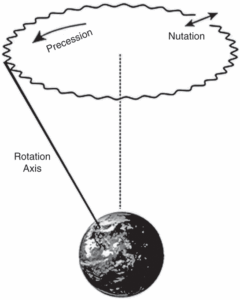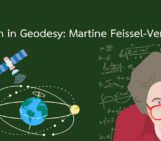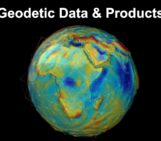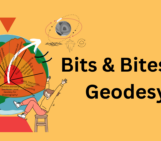
When we think of Earth’s rotation, it is tempting to imagine a perfectly smooth spin. But in reality, Earth’s rotation is irregular and dynamic, and is influenced by forces inside and outside of our planet. To describe the changing orientation of the Earth in space over time Earth Orientation Parameters (EOPs) are measured with fundamental geodetic measuring techniques, e.g., Very Long Baseline Interferometry (VLBI), Satellite Laser Ranging (SLR), and Global Navigation Satellite Systems (GNSS) in combination with the realization of International Terrestrial Reference Frames (ITRF). If you want to learn more about ITRFs, check out the post on geodetic reference frames.
The main EOPs describe the motion of the orientation of Earth’s rotation axis with respect to the Earth’s crust (polar motion) and to the celestial reference system (precession and nutation), and the speed the Earth is rotating (variations in the length of day). These measurements are important to enable precise positioning and are needed by astronomers to correctly point their telescopes. Moreover, these measurements are related to mass change signals like the melting of the ice sheets in Greenland and Antarctica. Now let’s focus on the different aspects that lead to a change in the orientation of Earth’s rotation axis, which leads to the motion of the poles over time.

Schematic Sketch of the movements of the rotational axis in precession and nutation from McCarthy, Dennis D.; Seidelmann, P. Kenneth (Eds.) (2018): Time: From Earth Rotation to Atomic Physics: Cambridge University Press.
Precession is a slow movement of the rotational axis in the celestial reference frame. It resembles the wobble of a spinning top, but this motion occurs over a long time: approximately 26,000 years. Precession is caused by gravitational pulls of the Sun and Moon. Most of the time Sun and Moon are not located perpendicular to the rotation axis, so their pull creates this wobbly motion of the rotation axis. We need to measure this motion with geodetic techniques because it leads to a gradual shift of the orientation of the poles with respect to the stars, and with that shifts the Spring and Fall equinoxes (moments when day and night are nearly equal due to the Sun being directly above the equator) over time. In addition to this slow, large wobble motion, there are shorter periodic oscillations from the Sun and Moon, summarised as nutation, that form a smaller motion over different periods. The main impact here comes from the Moon and repeats every 18.6 years. Together, precession and nutation result in a conical wobble of Earth’s rotational axis with a superimposed nutation pattern that you can see in Figure 1.
The effects of precession and nutation cause a long-term movement of Earth’s rotational axis with respect to the stars, meaning the celestial poles do not remain fixed. However, we often observe Earth using an Earth-fixed reference frame, in which the rotational axis is corrected for movements created by precession and nutation, but still, a change in the poles of the rotational axis is observed and has to be accounted for in terrestrial reference frames.

Observed polar motion (EOP 08 C04 of IERS) measured from 1962 to 2014 (modified from Rummel, Reinhard; Freeden, Willi (Eds.) (2017): Erdmessung und Satellitengeodäsie. Berlin: Springer Spektrum (Springer Reference Naturwissenschaften). Available online at http://www.springer.com/de/book/978-3-662-47099-2.)
This remaining motion is called polar motion and is the result of many dynamic processes on and inside the Earth acting together. Polar motion can be divided into an annual oscillation and the so-called Chandler oscillations, plus an additional trend. The annual oscillations are relatively stable and are caused by seasonal geodynamic and external gravitational processes. The Chandler oscillations have a period of about 432 days and exist because the rotational axis does not coincide with Earth’s axis of inertia. The Chandler wobble varies over time and is influenced by momentum exchanges in the atmosphere, ocean, and the Earth’s interior, such as mantle convection and liquid core motion. The trend results from significant changes caused by geophysical processes, e.g., glacial isostatic adjustment (GIA) and ice-melting in the polar areas and the corresponding redistribution of water in the ocean (see the post on GIA).
So, in other words, there are processes that make the poles wobble in periodic oscillations, but there are also mass distributions that lead the poles to wander, and it seems they will not settle down any time soon.
If you are interested in more details, you can have a look at a few publications to dive deeper into the topic:
Bizouard, C., Gambis, D.: The combined solution C04 for Earth orientation parameters consistent with international terrestrial reference frame 2005. In: Drewes, H. (Hrsg.) Geodetic Reference Frames. IAG Symposia, Bd. 134. Springer, Berlin (2009) Chandler, S.C.: On the variation of latitude I-IV. Astron. J. 11, 59–61, 65–70, 75–79, 83–86 (1891) Chandler, S.C.: On the variation of latitude V-VII. Astron. J. 12, 17–22, 57–72, 97–101 (1892) Chen, J.L., Wilson, C.R., Ries, J.C., Tapley, B.D.: Rapid ice melting drives Earth’s pole to the east. Geophys. Res. Lett. 40 (2013). doi:10.1002/grl.50552 Gross, R.S.: The excitation of the Chandler wobble. Geophys. Res. Lett. 27(15), 2329–2332 (2000) Torge, Wolfgang; Müller, Jürgen; Pail, Roland (2023): Geodesy. 5th. Boston: De Gruyter Oldenbourg (De Gruyter textbook).
– Edited by Rebekka Steffen and Öykü Koç




